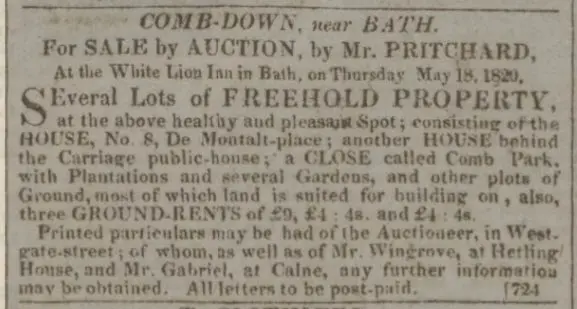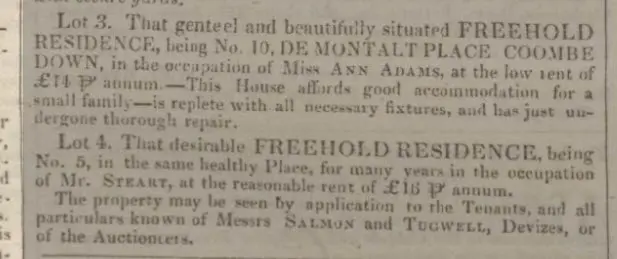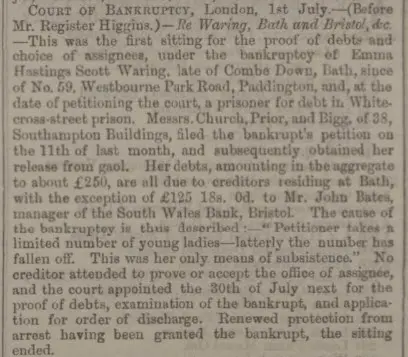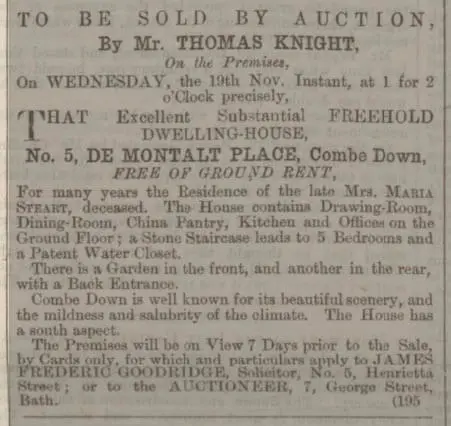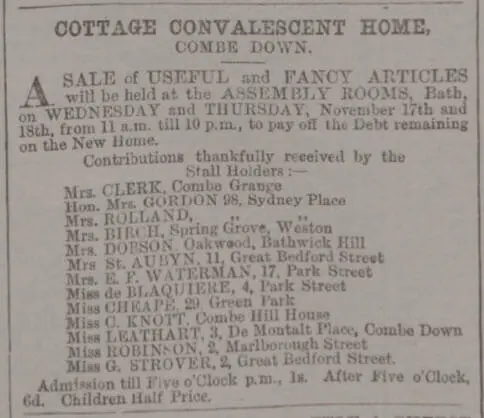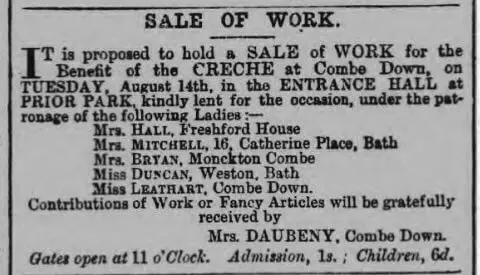
De Montalt Place was, of course, the first housing on Combe Down (rather than in Monkton Combe). It’s very well know that Ralph Allen built housing for his workers bought the quarries.
In 1780, Mr. Rack, Secretary of the Bath & West of England Agricultural Society wrote:
"The entire village of Combe Down consists of 11 houses built by Ralph Allen in 1729, for his quarrymen."
On 28th May 1788 John Chapman, Ralph Allen’s surviving trustee conveyed to the Rt. Hon. Lord de Montalt & his trustee ‘Freehold Lands in Lyncomb and Widcomb & Monckton Comb Somerset’ and that tells us some more about De Montalt Place as it then became known, though at the time it was known as ‘The Old Rank’.
...on a part of which the dais Ralph Allen in his lifetime built the following row of houses now standing thereon and made or laid out Gardens thereto that is to say a Messuage or Tenement Brewhouse Garden and Premises now used and enjoyed therewith in possession of William Butler being a Public House at the yearly rent of fifteen pounds four shillings and six pence one other Messuage or Tenement and Garden and Premises used and enjoyed therewith by Mordecai Rolwell at the yearly rent of Two pounds one other Messuage or Tenement and Garden with the Appurtenances used and enjoyed therewith by William Birchall at the yearly rent of Six pounds sixteen shillings and six pence one other Messuage or Tenement Stable and Garden with the Appurtenances used and enjoyed therewithby Charles Davis at the yearly rent of Seven pounds and seven shillings one other Messuage or Tenement Coach-house Stable and Garden with the Appurtenances used and enjoyed therewith by Edward Morton at the yearly rent of five pounds one other Messuage or Tenement and Garden with the Appurtenances used and enjoyed therewith by William Birchall and Mr. Roth or one of them at the yearly rent of four pounds and four shillings one other Messuage or Tenement Outhouse and Garden with the Appurtenances used and enjoyed therewith by Thomas Guest at the yearly rent of seven pounds seven shillings one other Messuage or Tenement and Garden with the Appurtenances used and enjoyed therewith by Mrs. Dinah Skrine at the yearly rent of six pounds one other Messuage or Tenement Garden and Appurtenances used and enjoyed therewith by William Orchard at the yearly rent of six pounds and Six shillings one other Messuage or Tenement Garden and Appurtenances used and enjoyed therewith by Mr. Robert Ward at the yearly rent of six pounds and six shillings one other Messuage or Tenement and Garden with the Appurtenances used and enjoyed therewith by Thomas Ward at the yearly rent of four pounds one other Messuage or Tenement and Garden with the Appurtenances used and enjoyed therewith by Mr. Grant at the yearly rent of six Guineas and one other Messuage or Tenement and Garden with the Appurtenances used and enjoyed therewith by William Warren at the yearly rent of six pounds and six shillings...
So we know that De Montalt Place originally consisted of 11 houses and was built in 1729 by Ralph Allen.
In 1765 it passed to his widow Elizabeth Holder but she died in 1766.
It then became the property of his niece Gertrude Tucker who was married to Rt Rev Dr William Warburton Bishop of Gloucester.
We also know that in 1788 it was conveyed to Cornwallis Maude, then Baron de Montalt and later 1st Viscount Hawarden, who had been married to Mary Allen, Ralph Allen’s niece, who had died in 1775.
They had a son Thomas Ralph Maude who was to become 2nd Viscount Hawarden and who was his mother’s legal heir.
Born in 1767 he would have reached his majority in 1788 and presumably the conveyance to Lord de Montalt was recognition of this by Gertrude Tucker and Ralph Allen’s trustees. The fact that his father then mortgaged his inheritance twice… Anyway when Cornwallis Maude, 1st Viscount Hawarden (1729 – 1803) died Thomas Ralph Maude succeeded.
He had to deal with his father’s debts and had to sell much of the Bath properties so to do. After his death in 1807, his half brother and successor Cornwallis Maude, 3rd Viscount Hawarden continued to sell.
It seems reasonable to assume, therefore, though I have yet to see any deeds for De Montalt Place, that it was part of the sale process and certainly by 1820 we have proof as 8 De Montalt Place was up for auction.
1833 – 5 & 10 De Montalt Place for sale
In 1833 5 & 10 De Montalt Place came up for sale. 5 was occupied by Mr Steart who, we can, probably, assume was the George Steart (1770 – 1837) of Bally, Ellen and Steart, papermakers of De Montalt Mill. George Steart made most of the coloured papers used by J M W Turner (1775-1851).[1]
George Steart’s manufacturing process is described by him in The Magazine of Science in 1843 and won him The Royal Society of Arts‘ Isis Silver Medal in 1821.
Bally, Ellen and Steart made the paper for Grenoble Bridge one of four progress colour studies made for Charles Holford (1774 – 1838). John Ruskin (1819 – 1900) praised it as: ‘among the most exquisite fragments existing of [Turner’s] central manner’.
George Steart married a lady named Maria (d. 1861) who continued to live at 5 De Montalt Place until her death at which time the house and her possessions were auctioned.[2]
When he died George Steart’s obituary said:[3]
At Combe Down, Mr. George Steart, of the firm of Bally, Ellen, and Steart, paper manufacturers. By his active and intelligent mind he brought into great re pute the De Montalt Mills, of which the water wheel is the largest in England. The new church on Combe Down was erected through his unwearied exertions, and to it he largely contributed.

Grenoble Bridge licensed under: Creative Commons CC-BY-NC-ND (3.0 Unported)
1841 – Census and Isaac Sumsion
The 1841 census showed the following occupation for De Montalt Place:
- James & Elizabeth Kewzer (Lodging house keeper)
- Edward & Lucy Palethorpe (Independent means)
- Elizabeth Franklin (Lodging house keeper)
- William & Jane Butler (Independent means)
- Maria Steart (Independent means)
- Joseph & Esther Taylor (Lodging house keeper)
- Mary Wilcox (Launderer)
- John & Elizabeth Miner (Baker)
- Fanny Smith (Independent means)
- Isaac & Eliza Sumsion (Quarry master)
- Ann Hewlett (School mistress)
Some of the people have been written about elsewhere and the links above take you to them.
What the census shows is the wide range of people living there. 4 state Independent Means as their income source, 3 are Lodging House Keepers, and then there’s a baker, launderer, school mistress and quarry master.
The quarry master living at 10 De Montalt Place is Isaac Sumsion (1801 – 1859) the son of Isaac Sumsion (1774 – 1779) and the father of Isaac Sumsion (1834 – 1909). The Sumsion family became a long line of quarry masters on Combe Down.
In 1808 Isaac Sumsion I had come to an agreement for a quarry on Combe Down with Nathaniel Hadley.
Memorandum of Agreement. A91/18/87 24 Sept. 1808. 1 acre on Coombe Down to be used a quarry. Nathaniel Hadley Esq. Isaac Sumsion. Consideration: £3 13s 6d per perch p.1/2 a.
The quarries could be dangerous places as the cutting from the Bath Chronicle shows. Unfortunately it’s not clear if this is Isaac Sumsion (1801 – 1859) or his son James (b. 1831).
Isaac Sumsion II had a sad end being admitted to Bailbrook House Lunatic Asylum on 16 Aug 1856 and died there on 4 Jan 1859.[4]
It’s not particularly well known that the Bailbrook House Hotel was an asylum for 140 years from 1830 – 1970.
It did not have a good report from the Commissioners in Lunacy in 1859 as the cutting shows. Lunacy according to the Victorians seems strange to us.
Lunatics included people with learning disabilities, epilepsy, dementia, grandiose delusions, neuro-syphilis, alcoholism, drug abuse, postnatal depression and puerperal fever as well as, sometimes, people the family just wanted locked away!
Bailbrook Lodge was started in 1790 for Dr Denham Skeet, a wealth lawyer, who had been living at Blaise Castle which he had bought in 1778. He sold Blaise Castle in 1789 to John Scandrett Harford (1785 – 1866) and decided to build Bailbrook Lodge though he never actually lived there. He employed John Eveleigh to build it spending over £17,000 and it was completed about 1801. By then Denham Skeet was in financial difficulties himself and in 1802 it was sold to Valentine Jones (1754 – 1813) for £7,000.
He had recently returned from the West Indies where after a varied career he had become the army’s Deputy Commissary General, and by a series of frauds had amassed £85,000 which is equivalent to about £92,310,000.00[5] in 2016! He was brought to trial in 1805, found guilty and sentenced to three years in Newgate.
Bailbrook Lodge then went through a succession of owners.
In 1830 it was bought by a retired naval surgeon, Dr Joseph Spry (1778 – 1859), who converted the house into a lunatic asylum for 16 private patients and eight paupers.
In 1838 Dr Spry sold Bailbrook House to Stephen Terry (1789 – 1848), a druggist. Successive members of the Terry family continued to run Bailbrook until 1886.
In 1886 the house and grounds were bought by Dr Lionel Alexander Weatherly (1852 – 1940). Under a succession of proprietors it continued in use as a lunatic asylum until 1971, then became the Bailbrook Nursing Home but closed in 1974.
In 1977 it was bought for £149,400 by a company called International Aeradio Ltd (now part of Serco) for use as a residential training college for international students in aviation, communications, electronics and related fields.[6]
In the 21st century it became a conference centre and then a hotel.
1848 – Ann Hewlett and 11 De Montalt Place
Ann Batchelor Hewlett (1795 – 1880), a school mistress, was in residence at 11 De Montalt Place in 1841.
She was obviously operating a school on Combe Down as early as 1827, as the cutting saying she was robbed shows and, it seems probable that it was at 11 De Montalt Place too. She also advertised in the Bath Chronicle and Weekly Gazette on Thursday 4 January 1844.
It’s also quite clear from the cutting about letting the house for a month in 1848 that she, probably, took a summer holiday.
It seems that she was running at first a Ladies Seminary. However, in 1850 an advert appears for a ‘Preparatory School for Young Gentlemen’ which it appears she had been solicited to open. Quite why she changed course is unclear.
The 1861 census shows her living at 9 De Montalt Place as a retired governess and the 1871 census also at 9 as an annuitant.

1852 – John & Anne Miner

In 1852 John Miner (1814 – 1890) was seeking work. He had been at 8 De Montalt Place since at least 1841 when his occupation had been given as baker, but by the 1851 census it was given as gardener.
His first wife Elizabeth Rumble (1811 – 1847) had died leaving him with 4 boys and 3 girls. He had then remarried in 1849 to Ann Perkins (1824 – 1880) and they had a boy and a girl by 1852 and were to go on and have a total of 3 boys and 2 girls meaning a family of 12 children.
See more at A history of the Miner family on Combe Down by Michael Miner.
Sometime between 1855 and 1858 he and his family emigrated to Australia his last 2 children were born there – his son Joseph Thomas was born in Raymond Terrace, New South Wales, Australia in 1858.
Australia had begun to shed its penal colony image, appealing to a wider demographic of migrants. In 1840, transportation of convicts to New South Wales had been suspended and by 1850 completely abolished. There were concerns about a shortage of skilled labour and the British Government was eager to colonise other areas of the continent. This contributed to the need for more free settlers, particularly skilled workers, to migrate to Australia. Since many could not afford the expense of travelling to Australia, in 1830 the assisted passage scheme was initiated for British migrants. There were also emigration societies set up to help with the labour shortage. Given that he seems to have had some difficulty in finding work emigration would have appealed to John Miner.
The Miner family also fitted the family grouping that was preferred for emigration. “…No families are better suited than those of which the parents, being 45 or even 50 years of age, have still power to work themselves, and at the same time can take out with them strong and healthy sons and daughters, of proper age to endure the mode of life at sea and to render themselves serviceable shortly after…”. Emigrants of ‘good moral character and industrious habits’ were sought, and these had to present testimonials of their good character from a clergyman or other notable person from their region of origin.
1855 – Robert Were, burglary at 8 De Montalt Place
There was a burglary at 8 De Montalt Place on 9 Feb 1855.
Robert Berwick Were (1794 – 1865) was a surgeon.
He married 3 times. First to Harriet Manley (1794 – 1868) with whom he had 3 children.
Then to Mary Elizabeth MacQueen (1792 – 1861).
Finally to Julianna Dowding (1807 – 1872).
1858 – Emma Scott-Waring’s ladies establishment
Emma Scott-Waring (1816 – 1893) was born in India.
Her father was Edward Warren Hastings Scott-Waring (1783 – 1821) and her grandfather John Scott-Waring (1747 – 1819) worked in the Honourable East India Company.
From her advert she seems to have travelled, speak a number of languages, be a good musician and had decided to move her school from Bristol to Bath at 1 De Montalt Place.
She was charging 50 guineas p.a. equivalent to about £36,090.00 in 2016![5]
For whatever reason the venture failed and she became bankrupt with debts of about £250 in 1863.
According to The London Gazette of 8 November 1867 she entered into a composition with creditors.
A composition with creditors is an agreement not only between the debtor and the creditors but also between the creditors themselves to accept less than what each is owed.
Usually, the agreement involves paying a reduced amount over a period of time.
Unfortunately Emma’s troubles were not over.
On 4 Oct 1886 she was admitted to Halliford House – a private mental asylum in Sunbury and died there in 1893.
An advert in 1872 in Plain Directions for Dealing with an Insane Patient said:
HALLIFORD HOUSE, SUNBURY, MIDDLESEX. This beautiful and secluded Residence, standing in a small park of nearly thirty acres, is appropriated to the reception of a limited number of patients of the higher classes who may be suffering from mental and nervous affections, and who are under the constant personal superintendence of Dr. Seaton, the proprietor. Halliford House is situate sixteen miles from London, and four from Hampton Court, and is easy of access by either omnibus or railway. The Thames Valley branch of the South-Western Railway has a station at Sunbury. It is also easy of access from the West of England by means of the Reading and Richmond line — the Feltham Station of which is distant three miles. It is equally easy of access from the South of England, being only three miles from the Walton Station of the South-Western Mainline.
1861 – William & Frances Elizabeth (née Evans) Coxhead
William Coxhead (1802 – 1884) & Frances Elizabeth Evans (1804 – 1890) lived at 10 De Montalt Place in 1851. The census says he’s a woollen draper and tailor and he operated from Gay Street then George Street.
He later went into business with a J Edmonds to form Coxhead & Edmonds from which he retired in 1869. He was also for many years a parish overseer and on the highways board.
He also became Treasurer for Combe Down Penny Bank. Penny Banks had been established as campaigners believed the poor should be encouraged to help themselves, by saving against times of ill health, unemployment and old age.
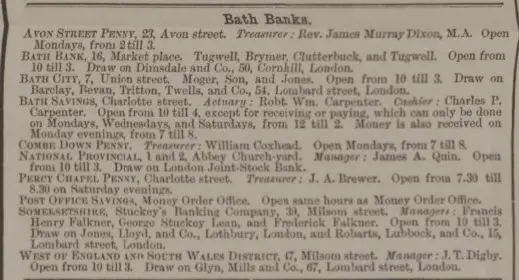
Penny banks were for people who couldn’t afford to join a regular savings bank. The first was set up in Greenock, Scotland, in 1847. Most savings banks required a minimum deposit of £1. Penny banks, however, allowed customers to deposit as little as a one penny. Once they had saved a pound, an account would be opened at the parent savings bank. The idea quickly caught on, and penny banks were established up and down the country, in Sunday schools, schools, mechanics’ institutes, and social clubs. Most banks were open once a week, on Saturday evenings between 6 and 8 p.m. though the Combe Down branch seems to have opened on Mondays from 7 – 8 p.m.
By 1867 there were 874 ‘penny banks’ in the United Kingdom (682 in England, 169 in Scotland) with slightly under £60,000 in total deposits.[7]
In 1882 Samuel Smiles said:
"...the Penny Bank is emphatically the poor man’s purse. The great mass of the deposits are paid in sums not exceeding sixpence, and the average of the whole does not exceed a shilling. The depositors consist of the very humblest members of the working class, and by far the greatest number of them have never before been accustomed to lay by any portion of their earnings..."[8]
1861 – Sampson Morris and Sarah Ann Bellringer (née Snook) Willis
Sampson Morris Willis (1810 – 1881) and Sarah Ann Bellringer Snook (1807 – 1894) lived at 7 De Montalt Place for at least 20 years.
He was born in Combe Hay, the first son of John William Willis (1772 – 1847) and Mary Morris (1791 – 1877) and had 7 brothers & 3 sisters. She was born in Priston in 1807, William Snook (1785 – 1862) and Susanah Bellringer (1779 – 1872) and was the first of 3 brothers and 2 sisters. They had 8 children, 4 boys and 4 girls.

He became first a Surveyor of the Highways at Dunkerton.
Under the Highways Act 1555 the burden for the upkeep of public highways became the responsibility of the parish as a whole. A subsequent act of 1691 required each parish to appoint a Surveyor of Highways (or Waywarden).
His duties included:
- taking over any balance of money from his predecessor
- becoming acquainted with on-going works
- viewing all the roads, byways, water courses and pavements make presentation upon oath in what condition he finds same
- requiring landowners near the roads to clear any overhanging hedges, timber, stones or other obstructions and cleanse & scour the adjoining gutters & drains
- waylaying any waggons, wains or carts etc. that are not drawn by the statutary number of oxen or horses
- arranging the six days of the year when parishioners were required to provide “Statute Labour Duty” and report any defaulter to the justices
- collecting any payment that was due from ‘poor cottagers and niggardly farmers’
The Highway Act 1835 continued most of these duties but allowed a Surveyor of the Highways to pay for the costs involved by rates levied on the occupiers of land.
Later he became a Relieving Officer of the Frome Road Workhouse, though, as the clipping shows, there were some questions about his approach.
The duties were:
- To attend all ordinary meetings of the Board of Guardians, and to attend all other meetings when summoned by the clerk.
- To receive all applications for relief made to him within his district, or relating to any parish situated within his district, and forthwith to examine into the circumstances of every case.
- In any case of sickness or accident requiring medical or surgical relief, to procure medical or surgical assistance, by giving an order on the district medical officer, or by such other means as the urgency of the case may require.
- To ascertain from time to time from the district medical officer, the names of any poor persons whom such medical officer may have attended or supplied with medicines, without having received an order from himself to that effect. In every case of sickness or accident of any poor person receiving medical relief, as soon as may be, and from time to time afterwards, to visit the home of such sick person, and until the next ordinary meeting of the Board of Guardians, to supply such relief (not being in money), as the case on his own view, or on the certificate of the district medical officer, may seem to require. In every case of sudden and urgent necessity, to afford such relief to the destitute person as shall be requisite, either by giving such person an order of admission to the workhouse, and conveying him thereto if necessary It is important for the relieving officer to observe, that it is his duty to visit at their dwellings all persons who have applied for relief, as soon as possible after he has received the application.
- To report to the Board of Guardians at their ordinary meetings, all cases reported to him by an overseer of the poor of any parish in the district for which he shall be appointed to act, in which relief shall have been given by such overseer.
- To give all reasonable aid and assistance at the request of any other relieving officer of the union, by examining into the case of any applicant for relief, or ‘administering relief to any pauper whose name has been entered on the books of such other relieving officer, and who may be within his own district.
- If required by the Board of Guardians, to apply to the persons appointed to pay the pensions payable to out pensioners, and to receive the amounts which shall be payable to the Board of Guardians, and forthwith to pay the same to the treasurer on their account. Duly and punctually to supply the weekly allowances of all paupers belonging to his district, and to relieve all paupers within his district to the amount and in the manner in which he may have been ordered to pay and relieve such paupers respectively by the Board of Guardians.
- To keep a separate, full, and true account of all monies received and disbursed by him, for or on account of the relief of the poor of each parish in the district for which he shall be appointed to act, and also of all articles received and given out by him, for the relief of the out-door poor; to balance such account weekly, and to present the same to the clerk for his inspection and authentication before every ordinary meeting of the Board of Guardians, and to the Board of Guardians, at such meeting, for their approval.
- In no case to take credit in his accounts, or enter as paid or given, any money or other articles which shall not have been paid or given previously to the taking of such credit, or the making of such entry; and not to take credit in such accounts for any money paid to any tradesman or other person, without producing, at the next ordinary meeting of the guardians, a bill from such tradesman or other person.
- To submit to the auditor of the union, all his books, accounts, and vouchers, at such place and time, and in such manner, as may be required by the regulations of the said commissioners in force at the time.
- To assist the clerk to the guardians in conducting and completing the annual or other election of guardians, according to the regulations of the Poor Law Commissioners in force at the time.
- To observe and execute all lawful orders and directions of the guardians applicable to his office.
1862 – 5 De Montalt Place for sale
1872 – 8 De Montalt Place for sale
1880 – Jessie Leathart
Jessie Leathart (1820 – 1905) was the daughter of Maj John Leathart (1749 – 1843) who had served in the Bengal Army who had come to Bath in 1810.[9] She lived at 2 De Montalt Place for at least 20 years.
She was, for many years, a stalwart of Bath Archers appearing many times in the Bath Chronicle and Weekly Gazette for example, inter-alia, Thursday 17 July 1862, Thursday 16 October 1862, Thursday 26 July 1866, Thursday 28 July 1870, Thursday 13 September 1877, Thursday 2 June 1881.
She was also prominent in Bath social circles and spent time raising funds for projects on Combe Down such as the Convalescent Home and a creche.
1891 – Census
The 1891 census showed the following occupation for De Montalt Place:
- Uninhabited
- Jessey Leathert (Living on own means)
- Francis James Brown (Pharmaceutical chemist)
- John Pearce & Mary Vickery (Cabinet maker & verger)
- Elizabeth Dowling (Living on own means)
- Mary Eliza Gore (Living on own means)
- Sarah Ann B Willis (Living on own means) & Amelia Willis (Lodging house keeper)
- Hester Mitchell (Living on own means)
- Katie Macpherson (Living on own means)
- Emma Lucy Jeans (Living on own means)
- Not shown

Compared with the 1841 census 50 years earlier there is a distinct change in the composition of the households.
7 of the households consist of single ladies or widows living on their own means with just Francis James Brown (b. 1839) and John Pearce Vickery (1852 – 1925) providing a contrast.
Jessie Leathart has already been touched on.
Elizabeth Dowling (née Tuthill) (1819 – 1905) had been a school mistress married to a school master but her husband George Dowling (1820 – 1888) had become Master of the Frome Road Workhouse, and she had been Matron. After he died she lost her job but she was granted an annuity of £52 – confirmed in the Bath Chronicle and Weekly Gazette, Thursday 27 September 1888 – which is equal to about £23,890.00 in 2016.[5]
Mary Eliza Gore (née Hole) (1813 – 1891) was the widow of Rev John Gore (1800 – 1871). Her husband had been Vicar of Shalbourne in Berkshire and a minor canon to College of St George at Windsor Castle. He was also the father of Caroline Letitia Gore (1843 – 1920) who was the third wife of Rev Reginald Guy Bryan M. A. (1819 – 1912) who was the vice-principal at Protestant College, Malta; Perpetual Curate at Fosbury, Wiltshire and the Principal at Monkton Combe College.
Sarah Ann B Willis is Sarah Ann Bellringer Snook (1807 – 1894) the widow of Sampson Willis. Amelia Willis (1851 – 1936) is their daughter.
Hester Mitchell (1818 – 1895) was a widow who had been a nurse and lived at 8 De Montalt Place for at least 20 years appearing in the 1871, 1881 and 1891 censuses.
Katie Macpherson (b. 1867) was a young widow of 24 with 2 children, Mona Kate N Macpherson (1886 – 1947) and Daisy Wingate Macpherson (1889 – 1960). By 1901 they had moved to Potternewton in Yorkshire.
Emma Lucy Jeans (1831 – 1921) was a spinster and lived at 11 De Montalt Place from at least 1891 – 1911.
Francis James Brown (b. 1839) was registered as a pharmaceutical chemist on 31 Dec 1868.[10] He had started as an assistant to John Kemp in North Street, Brighton in 1860, then practiced in Tetbury and Malmesbury before moving to Bath. He was a district councillor in 1894.
John Pearce (1852 – 1925) & Mary (née Vickery) (1855 – 1939) Vickery lived at 4 De Montalt Place. They had 5 boys and 4 girls. He had exhibited at Industrial and Art Exhibition at Fry’s Repository in Newark Street reported in the Bath Chronicle and Weekly Gazette on Thursday 29 December 1881.
1894 – 8 De Montalt Place for sale
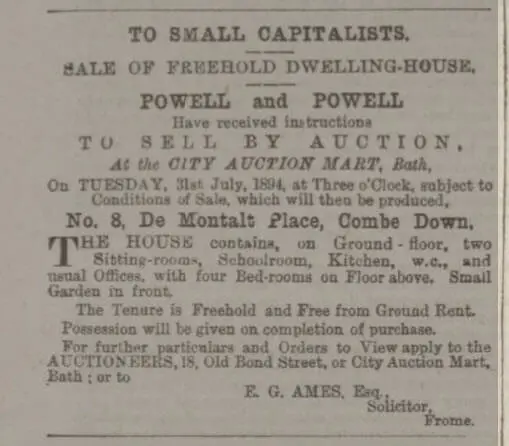
Contents
- 0.0.1 1833 – 5 & 10 De Montalt Place for sale
- 0.0.2 1841 – Census and Isaac Sumsion
- 0.0.3 1848 – Ann Hewlett and 11 De Montalt Place
- 0.0.4 1852 – John & Anne Miner
- 0.0.5 1855 – Robert Were, burglary at 8 De Montalt Place
- 0.0.6 1858 – Emma Scott-Waring’s ladies establishment
- 0.0.7 1861 – William & Frances Elizabeth (née Evans) Coxhead
- 0.0.8 1861 – Sampson Morris and Sarah Ann Bellringer (née Snook) Willis
- 0.0.9 1862 – 5 De Montalt Place for sale
- 0.0.10 1872 – 8 De Montalt Place for sale
- 0.0.11 1880 – Jessie Leathart
- 0.0.12 1891 – Census
- 0.0.13 1894 – 8 De Montalt Place for sale
- 1 Related Images:

